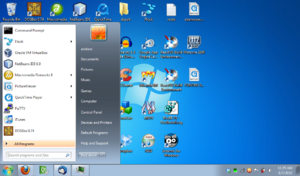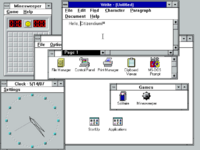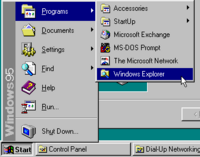Microsoft Windows: Difference between revisions
imported>Caesar Schinas (Replaced "fake" infobox with new Template:Infobox Software) |
mNo edit summary |
||
| (19 intermediate revisions by 7 users not shown) | |||
| Line 1: | Line 1: | ||
{{subpages}} | {{subpages}} | ||
{{TOC|left}} | |||
{{Infobox Software | {{Infobox Software | ||
| name = Microsoft Windows | | name = Microsoft Windows | ||
| screenshot = | | screenshot = MSWindows7.png | ||
| website = www.microsoft.com/windows | | website = www.microsoft.com/windows | ||
| developer = [[Microsoft Corporation]] | | developer = [[Microsoft Corporation]] | ||
| type = [[Operating System]] | | type = [[Operating System]] | ||
| release_first = 1.01 (Nov 1985) | | release_first = 1.01 (Nov 1985) | ||
| release_stable = | | release_stable = Windows 8.1 (October 2013) | ||
| source_model = [[Closed source software|Closed source]] | | source_model = [[Closed source software|Closed source]] | ||
| licence = [[MS-EULA]] | | licence = [[MS-EULA]] | ||
| Line 15: | Line 16: | ||
| platform = [[x86]], [[x86-64]] | | platform = [[x86]], [[x86-64]] | ||
}} | }} | ||
'''Microsoft Windows''' is the name of several families of [[closed source software]] [[operating system|operating systems]]. Windows was first released by [[Microsoft]] in | '''Microsoft Windows''' is the name of several families of [[closed source software]] [[operating system|operating systems]]. Windows was first released by [[Microsoft]] in 1985. Windows holds approximately 90% of the desktop operating system market<ref name=linuxworld>[http://www.linuxworld.com.au/index.php/id;940707233;fp;2;fpid;1 IDC: Consolidation to Windows won't happen] www.linuxworld.com.au</ref> and has been known to contain a great number of security threats throughout the years, partly because it is the most targeted system by [[malware]] developers. Windows has a [[graphical user interface|graphical system]], and was the first Microsoft product to allow input from devices such as a [[mouse (computers)|mouse]]. Before Windows, users of the Microsoft operating systems were limited to command line (plain text) input. | ||
Computers running Windows have commonly been referred to as [[Personal Computer|Personal Computers]] (PCs) for many years, as opposed to [[Macintosh|Macs]], [[Workstation computer|workstation computers]], and [[Supercomputer|supercomputers]]. A Windows system is typically found in the home and office environment, completing tasks for nearly every conceivable type of work, from displaying and editing text documents, to [[gaming]] and displaying [[X-ray|x-rays]]. A version of Windows (called [[Windows Media Center Edition]] or MCE) is specifically geared toward acting as a "Media hub," providing rich content and various types of leisure, such as watching [[television]] or [[high definition]] movies. | Computers running Windows have commonly been referred to as [[Personal Computer|Personal Computers]] (PCs) for many years, as opposed to [[Macintosh|Macs]], [[Workstation computer|workstation computers]], and [[Supercomputer|supercomputers]]. A Windows system is typically found in the home and office environment, completing tasks for nearly every conceivable type of work, from displaying and editing text documents, to [[gaming]] and displaying [[X-ray|x-rays]]. A version of Windows (called [[Windows Media Center Edition]] or MCE) is specifically geared toward acting as a "Media hub," providing rich content and various types of leisure, such as watching [[television]] or [[high definition]] movies. | ||
| Line 22: | Line 23: | ||
There are two development tracks of Windows that were kept updated through subsequent versions: versions of Windows which still relied on an [[MS-DOS]] subsystem, and [[Microsoft Windows NT|Windows NT]], which was written from scratch on a completely new, [[Hybrid microkernel]] design. | There are two development tracks of Windows that were kept updated through subsequent versions: versions of Windows which still relied on an [[MS-DOS]] subsystem, and [[Microsoft Windows NT|Windows NT]], which was written from scratch on a completely new, [[Hybrid microkernel]] design. | ||
===Windows 1.0 through Windows | ===Windows 1.0 through Windows 3.1=== | ||
{{Image|Win31.png|right|200px|Screenshot of Windows version 3.1}} | |||
Windows started life as an attempt at creating a [[graphical user interface]] on top of [[MS-DOS]]. The first " | Windows started life as an attempt at creating a [[graphical user interface]] on top of [[MS-DOS]]. The first "breakthrough" version of Windows that started gaining in popularity was Windows 3.0. Earlier versions weren't feature complete in various ways yet, such as they didn't support overlapped windows, and they couldn't run MS-DOS programs very well. Windows 3.0 changed all that, and combined with the addition of [[Microsoft Office]] for Windows, popularity (and sales) of Windows boomed. Windows 3.1, usually running atop DOS 6.2, was the last release in this line. | ||
=== Windows/95/98/ME=== | |||
In | {{Image|Win95 start.png|right|200px|The original Start menu in Windows 95}} | ||
In 1995, Microsoft completely re-designed the Windows interface with the new Windows 95 operating system. This was a real stand-alone operating system, not just a skin atop DOS. | |||
The | Windows 95 also introduced the [[Start menu|"Start menu"]]. The Start menu is contained in a button on the lower left of the screen (by default; it can be moved). When clicked, this button displays a list of groups, such as Programs, Documents, and Settings, in addition to some special buttons, such as Help, Run, and Shut Down. Each group is a sub-menu of files or programs. Each sub-menu can be divided into even more groups, so everything inside it can be organized. | ||
===Windows NT through Windows | Windows 95 was followed by Windows 98, then 98 SE (second edition) with some important bug fixes. The lineage of Windows as a 16 bit, then hybrid 32-bit operating system ended with the release of Windows ME, Millennium Edition. The next version of Windows, Windows XP (Windows NT 5.1) merged the two product lines together, with Windows XP Home for home users and Windows XP Professional for business users. | ||
The [[Microsoft Windows NT]] project was created because Microsoft needed an operating system that could compete with Unix workstations in terms of software stability, reliability and scalability. Windows NT was originally intended to complement the MS-DOS based versions of Windows, and provide a viable, marketable platform for businesses. | |||
===Windows NT through Windows 7=== | |||
The [[Microsoft Windows NT]] (NT = New Technology) project was created because Microsoft needed an operating system that could compete with Unix workstations in terms of software stability, reliability and scalability. Windows NT was originally intended to complement the MS-DOS based versions of Windows, and provide a viable, marketable platform for businesses. | |||
Microsoft intentionally "rebuilt from scratch" Windows NT, and its architecture still serves as the base of Windows Vista and the [[Windows Server]] line of Microsoft products | Microsoft intentionally "rebuilt from scratch" Windows NT, and its architecture still serves as the base of Windows Vista and the [[Windows Server]] line of Microsoft products | ||
In October of 1988 [[Dave Cutler]] and several hand picked engineers from the [[Digital Equipment Corporation]] [[VMS]] team was hired away and assigned a new project: build a viable operating system for enterprise users that would focus on reliability. | In October of 1988 [[Dave Cutler]] and several hand picked engineers from the [[Digital Equipment Corporation]] [[VMS]] team was hired away and assigned a new project: build a viable operating system for enterprise users that would focus on reliability. | ||
NT Release 5 was renamed Windows 2000 for marketing reasons. | |||
'''TODO:''' Much, much more on Windows NT development. [http://www.amazon.com/Show-Stopper-Breakneck-Generation-Microsoft/dp/0029356717 "Show Stopper!: The Breakneck Race to Create Windows NT and the Next Generation at Microsoft (Hardcover)] would be a great source for this work. | '''TODO:''' Much, much more on Windows NT development. [http://www.amazon.com/Show-Stopper-Breakneck-Generation-Microsoft/dp/0029356717 "Show Stopper!: The Breakneck Race to Create Windows NT and the Next Generation at Microsoft (Hardcover)] would be a great source for this work. | ||
==Developer tools== | |||
* [[Visual Studio]] is Microsoft's version of an IDE. | |||
==System administrator tools== | |||
===Windows PE=== | |||
==References== | ==References== | ||
{{reflist|2}}[[Category:Suggestion Bot Tag]] | |||
Latest revision as of 06:01, 19 September 2024
| Microsoft Windows | |
|---|---|

| |
| Website | www.microsoft.com/windows |
| Developed by | Microsoft Corporation |
| Software type | Operating System |
| Initial release | 1.01 (Nov 1985) |
| Latest release | Windows 8.1 (October 2013) |
| Source model | Closed source |
| Licence | MS-EULA |
| OS Family | Windows NT-based |
| Kernel Type | Hybrid microkernel (Windows NT-based) |
| Default UI | Windows Aero (GUI) |
| Platforms | x86, x86-64 |
Microsoft Windows is the name of several families of closed source software operating systems. Windows was first released by Microsoft in 1985. Windows holds approximately 90% of the desktop operating system market[1] and has been known to contain a great number of security threats throughout the years, partly because it is the most targeted system by malware developers. Windows has a graphical system, and was the first Microsoft product to allow input from devices such as a mouse. Before Windows, users of the Microsoft operating systems were limited to command line (plain text) input.
Computers running Windows have commonly been referred to as Personal Computers (PCs) for many years, as opposed to Macs, workstation computers, and supercomputers. A Windows system is typically found in the home and office environment, completing tasks for nearly every conceivable type of work, from displaying and editing text documents, to gaming and displaying x-rays. A version of Windows (called Windows Media Center Edition or MCE) is specifically geared toward acting as a "Media hub," providing rich content and various types of leisure, such as watching television or high definition movies.
History
There are two development tracks of Windows that were kept updated through subsequent versions: versions of Windows which still relied on an MS-DOS subsystem, and Windows NT, which was written from scratch on a completely new, Hybrid microkernel design.
Windows 1.0 through Windows 3.1
Windows started life as an attempt at creating a graphical user interface on top of MS-DOS. The first "breakthrough" version of Windows that started gaining in popularity was Windows 3.0. Earlier versions weren't feature complete in various ways yet, such as they didn't support overlapped windows, and they couldn't run MS-DOS programs very well. Windows 3.0 changed all that, and combined with the addition of Microsoft Office for Windows, popularity (and sales) of Windows boomed. Windows 3.1, usually running atop DOS 6.2, was the last release in this line.
Windows/95/98/ME
In 1995, Microsoft completely re-designed the Windows interface with the new Windows 95 operating system. This was a real stand-alone operating system, not just a skin atop DOS.
Windows 95 also introduced the "Start menu". The Start menu is contained in a button on the lower left of the screen (by default; it can be moved). When clicked, this button displays a list of groups, such as Programs, Documents, and Settings, in addition to some special buttons, such as Help, Run, and Shut Down. Each group is a sub-menu of files or programs. Each sub-menu can be divided into even more groups, so everything inside it can be organized.
Windows 95 was followed by Windows 98, then 98 SE (second edition) with some important bug fixes. The lineage of Windows as a 16 bit, then hybrid 32-bit operating system ended with the release of Windows ME, Millennium Edition. The next version of Windows, Windows XP (Windows NT 5.1) merged the two product lines together, with Windows XP Home for home users and Windows XP Professional for business users.
Windows NT through Windows 7
The Microsoft Windows NT (NT = New Technology) project was created because Microsoft needed an operating system that could compete with Unix workstations in terms of software stability, reliability and scalability. Windows NT was originally intended to complement the MS-DOS based versions of Windows, and provide a viable, marketable platform for businesses.
Microsoft intentionally "rebuilt from scratch" Windows NT, and its architecture still serves as the base of Windows Vista and the Windows Server line of Microsoft products
In October of 1988 Dave Cutler and several hand picked engineers from the Digital Equipment Corporation VMS team was hired away and assigned a new project: build a viable operating system for enterprise users that would focus on reliability.
NT Release 5 was renamed Windows 2000 for marketing reasons.
TODO: Much, much more on Windows NT development. "Show Stopper!: The Breakneck Race to Create Windows NT and the Next Generation at Microsoft (Hardcover) would be a great source for this work.
Developer tools
- Visual Studio is Microsoft's version of an IDE.
System administrator tools
Windows PE
References
- ↑ IDC: Consolidation to Windows won't happen www.linuxworld.com.au

